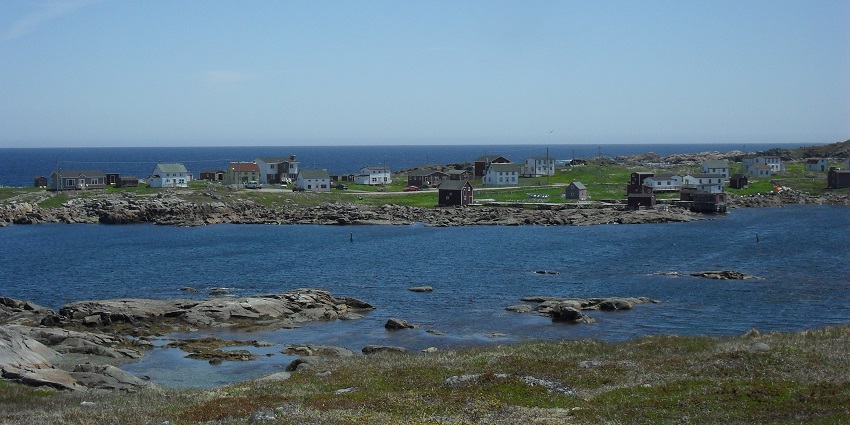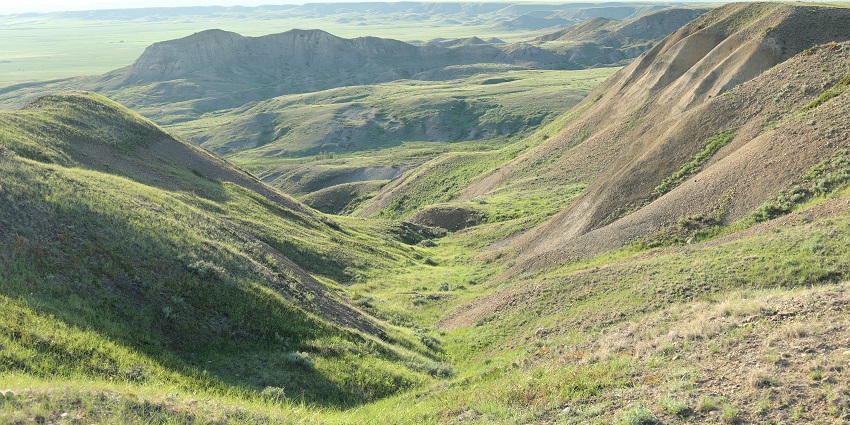Some of the most memorable places in Canada are the ones most people miss. These hidden places in Canada are far from busy highways and crowded parks. They sit quietly in remote corners, places where the land still leads the way. From quiet islands and old fishing villages to untouched valleys and strange crater lakes, each place feels like a secret. You won’t find large crowds or bright signs, just quiet beauty and stories that live in the land. For travellers who prefer the path less taken, these places are worth the effort.
Discover The 12 Hidden Places In Canada
These hidden places in Canada are tucked away in quiet corners. They remain untouched, often overlooked, but they offer something truly different to those who find them.
1. Haida Gwaii, British Columbia

Photo: Brett Hodnett / Wikimedia Commons
Haida Gwaii is a series of around 150 islands off the northern Pacific coast of British Columbia. It was once called the Queen Charlotte Islands but was changed to reflect the deep connection with the Haida people, who have lived here for thousands of years. The two largest islands are Graham and Moresby. Together, they cover over 10,000 square kilometres of rugged land shaped by rainforests, dramatic shorelines, and rich wildlife.
Cost: $300-500 / ₹25,000-43,000 for flight
Best Time To Visit: May – September
Nearby Attractions: Gwaii Haanas National Park, Tow Hill, Balance Rock
2. Kootenay Plains, Alberta

Photo: Jakub Fryš / Wikimedia Commons
Kootenay Plains is a protected area in central Alberta, around 150 kilometres west of Rocky Mountain House. It lies between two mountain ridges and offers a rare stretch of montane grasslands and open forests. The region is shaped by dry conditions and warm winds, which make it different from the nearby alpine zones. Here, you can find elk, mule deer, and over 60 types of birds. Aspen, sagebrush, and lodgepole pine grow across the land, giving the plains a different scenery in every season.
Best Time To Visit: June – October
Nearby Attractions: Siffleur Falls, Abraham Lake, Allstones Lake Trail
3. Manicouagan Reservoir, Quebec

Photo: J-A Béland / Wikimedia Commons
Manicouagan Reservoir, also called Lake Manicouagan, is a massive annular lake in central Quebec shaped by a meteorite impact that occurred over 200 million years ago. The lake’s circular form surrounds René-Levasseur Island, which includes Mount Babel, rising 952 metres above sea level. Its distinct ring-like shape is visible from space, which is why it’s often called the “eye of Quebec.” Fishing, snowshoeing, hiking, and wildlife tours take place around the lake, especially near Uapishka Station, which offers a base for backcountry adventures in the region.
Cost: $50 / ₹4300 for the tour
Best Time To Visit: June – September
Nearby Attractions: Daniel-Johnson Dam, Uapishka Biodiversity Reserve
4. Athabasca Sand Dunes, Saskatchewan

Photo: Dicklyon / Wikimedia Commons
The Athabasca Sand Dunes lie along the south shore of Lake Athabasca in Saskatchewan’s far northwest. Stretching more than 100 kilometres, they are the most northerly active dunes on Earth and the largest of their kind in Canada. Some reach 30 metres high, shaped by winds over thousands of years. The dunes were formed after the last glacial period, and today, they are one of the rarest landscapes in the province. The park covers over 1,900 square kilometres and sits within the Boreal Shield, home to several rare and endemic plant species which do not grow anywhere else.
Cost: $500 / ₹43,000 for chartered flights
Best Time To Visit: June 0 August
Nearby Attractions: Lake Athabasca, Fond du Lac River, Black Bay
5. Tilting, Fogo Island, Newfoundland And Labrador

Photo: SemanticsDavid / Wikimedia Commons
Tilting is a coastal village located on the eastern end of Fogo Island, off the northeast coast of Newfoundland. With roots tracing back to Irish settlers in the early 1700s, it holds a rare place in Canada’s cultural heritage. The entire community has been recognised as both a National Historic Site and a Provincial Heritage District. Narrow lanes restored saltbox houses, and old fishing stages line the shores, reflecting a way of life shaped by sea, wind, and tradition. Among the most hidden places in Canada, Tilting stands out for preserving its Irish dialect, customs, and landscape.
Cost: $8 / ₹700 for ferry ride
Best Time To Visit: June – September
Nearby Attractions: Brimstone Head, Fogo Island Inn, Joe Batt’s Arm
6. The Crack, Killarney Provincial Park, Ontario

Photo: Mrspaceweb / Wikimedia Commons
The Crack is a steep hiking trail tucked inside Killarney Provincial Park, part of the La Cloche Mountain range in northern Ontario. The first stretch is fairly gentle, cutting through pine and birch forest, but the climb quickly becomes difficult. Hikers must scramble over rocky slopes and boulder fields before reaching a narrow crevice sliced into quartzite cliffs. From the top, the view opens wide across ridges, lakes, and forested valleys. The final ascent is steep and challenging, and the trail is moderate to difficult. Camping is available in the park.
Cost: $12.25 / ₹1100
Best Time To Visit: May – October
Nearby Attractions: La Cloche Mountains, George Lake, Killarney Village
7. Pingualuit Crater, Nunavik, Quebec

Photo: Lkovac / Wikimedia Commons
Pingualuit Crater, often called the “Crystal Eye of Nunavik,” is a perfectly round meteorite impact crater on the Ungava Peninsula in northern Quebec. It spans 3.44 kilometres and rises 160 metres above the tundra. Formed about 1.4 million years ago, it holds Pingualuk Lake, known for its clear, turquoise water and salinity of less than 3 ppm, among the purest in the world. The lake is 400 metres deep, making it one of the deepest in North America. As one of the most surreal hidden places in Canada.
Cost: $3,000-5,000 / ₹2,60,000-4,30,000 for guided tour
Best Time To Visit: March – April & July – August
Nearby Attractions: Pingualuit National Park, Hudson Strait
8. Grasslands National Park- East Block, Saskatchewan

Photo: Cephas / Wikimedia Commons
The East Block of Grasslands National Park lies in southern Saskatchewan. It is known for its badlands, wide skies, and rare fossil beds. This section of the park is also one of the first places in Canada where dinosaur fossils were found, and visitors can still join guided digs led by palaeontologists. Fossil Fever is held here each year, allowing guests to uncover prehistoric bones with help from museum experts. The Scenic Badlands Parkway offers dramatic views from high plateaus, while wildlife sightings include prairie dogs, rattlesnakes, and coyotes.
Cost: $29 / ₹2500 (entry fee & camping fee)
Best Time To Visit: May – October
Nearby Attractions: Badlands Parkway, Rock Creek Trail, Fossil exhibit
9. Ghost River Valley, Alberta

Tucked in the eastern edge of Alberta’s Rockies, the Ghost River Valley is known for its jagged cliffs, glacier-carved valleys, alpine meadows, and cold mountain streams. This is one of just three wilderness areas officially designated in Alberta, protected since 1967. As one of the wildest hidden places in Canada, the valley attracts those who want total silence and space. Trails lead through steep terrain with routes like Lesueur Ridge, Black Rock Mountain, and Bastion Ridge. In winter, the North Ghost River becomes a hotspot for ice climbing.
Best Time To Visit: June – September
Nearby Attractions: Devil’s Head, Waiparous Creek, Big Hill Springs
10. Cape Chignecto Coastal Trail, Nova Scotia

Photo: Maamarcos / Wikimedia Commons
Cape Chignecto Coastal Trail loops around the edge of Nova Scotia’s largest provincial park, following cliffs, beaches, and dense forest along the Bay of Fundy. The 52-kilometre route starts near Advocate Harbour and takes three to four days to complete. Hikers move through a mix of backcountry and frontcountry terrain, where the trail climbs over headlands and drops into secluded coves. The view from the cliffs includes sea stacks like the Three Sisters and a vast open ocean. It’s long, isolated, and best suited for hikers who are prepared for tough weather and steep, muddy ground.
Cost: $34 / ₹3000 for a trail pass and camping
Best Time To Visit: May – October
Nearby Attractions: Three Sisters sea stacks, Cape d’Or Lighthouse
11. Ivvavik National Park, Yukon

Photo: Daniel Case / Wikimedia Commons
Ivvavik National Park is located above the Arctic Circle in the Yukon, touching the Beaufort Sea. The name “Ivvavik” means “a place for giving birth,” as this land is a calving ground for the Porcupine caribou herd. This is one of the most untouched, hidden places in Canada, where sharp ridgelines, glacial valleys, and tundra stretch across the northern wilderness. With fewer than 200 visitors a year, it offers rare access to Arctic wildlife, traditional knowledge, and vast, quiet land where self-reliance is essential.
Cost: $4,000 / ₹3,40,000
Best Time To Visit: June – August
Nearby Attractions: Firth River, Sheep Slot Canyon
12. Spotted Lake (Khiluk), British Columbia

Photo: Kevin He / Wikimedia Commons
Spotted Lake, also known as Lake Khiluk, lies in the eastern Similkameen Valley, just northwest of Osoyoos. This shallow, saline lake spans nearly 15 hectares and is rich in minerals such as magnesium sulphate, calcium, sodium sulphate, and traces of silver and titanium. During summer, much of the water evaporates, leaving hundreds of circular “spots” behind, each formed by a unique concentration of minerals. These spots change in size and colour, from bright blue to green and yellow, depending on the weather and mineral mix. Among the most spiritually significant hidden places in Canada, this lake is sacred to the Okanagan First Nations.
Best Time To Visit: July – September
Nearby Attractions: Osoyoos Desert Centre, Anarchist Mountain viewpoint
The most lasting moments often come from the quietest places. These hidden places in Canada are shaped by weather, time, and the people who know them best. There is no rush here, just open land, long stories, and the feeling of being somewhere that still belongs to itself. Plan your visit with TripXL for a slow, thoughtful, and rooted travel in the places that deserve to be seen with care.
Cover Photo: Murray Foubister / Wikimedia Commons


 WhatsApp
WhatsApp
 Twitter
Twitter









